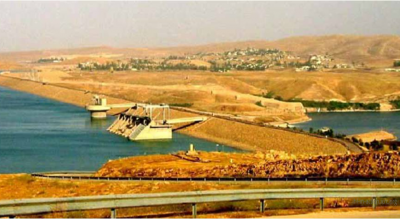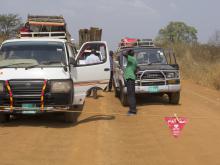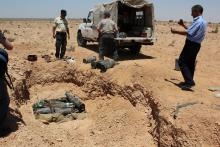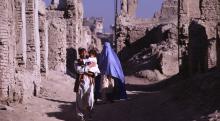Basic international humanitarian law (IHL) rules applicable to this situation:
Parties to the conflict must distinguish between civilians and combatants, and between civilian objects and military objectives. Attacks may only be directed against combatants or military objectives (principle of distinction).
Civilian objects are protected against attack, unless and for such time as they are military objectives.
In conducting military operations, constant care must be taken to spare the civilian population, civilians and civilian objects. All feasible precautions must be taken to avoid, and in any event to minimize, incidental loss of civilian life, injury to civilians and damage to civilian objects including when choosing means and methods of warfare (principle of precautions in attack).
Particular care must be taken if works and installations containing dangerous forces, including dams and other installations in their vicinity, are attacked, to avoid the release of those forces and consequent civilian losses.
The general principles and rules on the conduct of hostilities, including the principles of distinction, proportionality and precautions, apply to the natural environment by virtue of its civilian character. Methods and means of warfare must be employed with due regard to the protection and preservation of the natural environment. The use of methods or means of warfare that are intended, or may be expected to cause widespread, long-term and severe damage to the natural environment is prohibited; and the destruction of the natural environment may not be used as a weapon.
The case in brief
The Mosul Dam, in northern Iraq, retains a vast reservoir and is of critical importance to the local population, supplying electricity to the city of Mosul and controlling agricultural water supply to most of the region.
In 2014, armed conflict broke out between the Iraqi government and the Islamic State group (ISg), a non-state armed group, over control of Iraqi territory. An international coalition led by the United States (US) and Peshmerga forces from the autonomous Iraqi Kurdistan Region fought alongside Iraqi forces. In August 2014, the dam fell under ISg control.
Peshmerga and Iraqi armed forces conducted ground operations in conjunction with coalition air support to retake and establish control of the fragile dam, thereby respecting the heightened protections afforded to critical infrastructure under IHL and avoiding a potential humanitarian disaster.
IHL compliance highlights
- Recognizing that the dam’s failure would have catastrophic humanitarian consequences, the US president authorized targeted US airstrikes to support Iraqi and Peshmerga forces in recapturing it from ISg. He specified that the strikes would be ‘limited in their scope and duration’, sufficient to enable Iraqi forces to reestablish control over the site.
- Between 15 and 18 August 2014, the US military reportedly conducted 38 airstrikes around the dam, targeting military objectives including armed vehicles and an improvised explosive device emplacement.
Case prepared by James Patrick Sexton, Emma Persson, and Shaya Javadinia, LL.M. students at Leiden University, under the supervision of Professor Robert Heinsch, as well as Alla Ershova (Senior Researcher) and Ashley Peltier (Researcher), Kalshoven-Gieskes Forum, Leiden University.
A. CRITICAL NATURE OF MOSUL DAM IN IRAQ
[Source: Alessandro Annunziato, Ioannis Andredakis, and Pamela Probst, ‘Impact of flood by a possible failure of the Mosul dam: Hydrodynamic Simulations’, European Commission JRC Technical Reports, 2016, p. 5, available at https://publications.jrc.ec.europa.eu/repository/bitstream/JRC101555/lbna27923enn.pdf, accessed on 31 January 2021]
[…] 1.1 Basic dam information
The dam of Mosul was constructed between 1981 and 1986 in northern Iraq. It dams the river Tigris, forming an artificial lake that holds 11.1 km³ of water at full capacity and its primary function is to control water flow in the Tigris river. It is located 40km NW of the city of Mosul and its primary function is to supply electricity to the city’s 1.7 million inhabitants. It is the largest dam in Iraq, measuring 2km in length and 113m in height.
[...]
1.2 Dam instability
Concerns about the dam’s stability and safety began already during construction: because the dam is built on a foundation of gypsum, anhydrite, and limestone, i.e. water-soluble minerals, water can seep under the dam and compromise its stability, posing the risk of catastrophic failure.
[...]
B. UNITED STATES AUTHORISES MOSUL DAM OPERATION
[Source: President Obama, ‘Letter from the President – War Powers Resolution regarding Iraq’, 17 August 2014, available at https://obamawhitehouse.archives.gov/the-press-office/2014/08/17/letter-president-war-powers-resolution-regarding-iraq, accessed on 31 January 2021]
[...] On August 14, 2014, I authorized the U.S. Armed Forces to conduct targeted air strikes to support operations by Iraqi forces to recapture the Mosul Dam. These military operations will be limited in their scope and duration as necessary to support the Iraqi forces in their efforts to retake and establish control of this critical infrastructure site, as part of their ongoing campaign against the terrorist group the Islamic State of Iraq and the Levant (ISIL). The failure of the Mosul Dam could threaten the lives of large numbers of civilians, endanger U.S. personnel and facilities, including the U.S. Embassy in Baghdad, and prevent the Iraqi government from providing critical services to the Iraqi populace. Pursuant to this authorization, on the evening of August 15, 2014, U.S. military forces commenced targeted airstrike operations in Iraq.
I have directed these actions, which are in the national security and foreign policy interests of the United States, pursuant to my constitutional authority to conduct U.S. foreign relations and as Commander in Chief and Chief Executive. These actions are being undertaken in coordination with the Iraqi government.
[...]
C. ACTIONS TAKEN BY THE UNITED STATES HELP TO SAFELY RECAPTURE THE MOSUL DAM
[Source: Martin Pengelly, ‘US bombers help Kurds retake dam as Obama writes to Congress’, The Guardian, 17 August 2014, available at https://www.theguardian.com/world/2014/aug/17/us-ramps-up-iraq-air-strikes-kurdish-attack-dam, accessed on 31 January 2021]
The US on Sunday launched two waves of air strikes against Islamic State (Isis) militants in northern Iraq, in the most extensive American military operations in the country since the withdrawal of ground troops in 2011.
The strikes helped Kurdish peshmerga fighters to regain control of the strategically important Mosul dam captured by militants two weeks ago.
“Mosul Dam was liberated completely,” Ali Awni, an official from Iraq’s main Kurdish party, told AFP, a statement confirmed by two other Kurdish sources.
Early in the day US aircraft, for the first time including land-based bombers, carried out 14 strikes. Later, US Central Command confirmed further strikes had been carried out by “fighter and attack aircraft”.
[...]
The US has consistently cited the security of US personnel in Baghdad as cover for its military operation to support the Kurds.
[...]
A statement from US Central Command said the 14 strikes had been carried out “to support humanitarian efforts in Iraq and support Iraqi security forces and Kurdish defence forces”. Isis fighters around the dam and the Kurdish capital of Irbil were hit nine times on Saturday.
[...]
The statement said the strikes damaged or destroyed “10 armed vehicles, seven Humvees, two personnel carriers and one checkpoint”, and added that all aircraft involved had “exited the strike areas safely”.
The second statement from Central Command said the second wave of strikes, which were not numbered, had “destroyed three armed vehicles, a vehicle-mounted anti-aircraft artillery gun, a checkpoint and an IED emplacement”. All aircraft involved were again reported to have returned.
In his letter to Congress, Obama said the strikes had been authorised in order to “recapture the Mosul dam”.
[...]
[Source: Mitchell Prothero, ‘Obama: Iraqis, U.S. recapture Mosul Dam from militants’, Miami Herald, 18 August 2014, available at https://www.miamiherald.com/news/article1980474.html, accessed on 31 January 2021]
[...] Obama said there had been important strides in Iraq in recent weeks as the United States conducted airstrikes across the nation.
“We will continue to pursue a long-term strategy to turn the tide against ISIL by supporting the new Iraqi government and working with key partners in the region and beyond,” Obama said. “There should be no doubt that the United States military will continue to carry the limited missions that I’ve authorized, protecting our personnel and facilities in Iraq in both Irbil and Baghdad and providing humanitarian support.”
Officials from both the Iraqi Defense Ministry and the Kurdish security forces claimed that the dam, which controls the agricultural water supply to most of northern Iraq as well as Mosul’s electric generation capacity, was under the control of the joint Iraqi-Kurdish force, although the facility itself had to be cleared of booby-traps and mines left behind by retreating fighters from the Islamic State, a rogue al Qaida offshoot that recently declared itself an Islamic caliphate.
[...]
“U.S. advisers are on the scene with the Golden Brigade [Iraq special forces unit] helping coordinate the airstrikes,” the Iraqi official said, not giving his name in accordance with an agreed media blackout on the issue. “They have done great damage to Daash and the momentum is with us as they retreat back towards Mosul.”
According to U.S. Central Command, it has conducted 68 airstrikes since the operation began; of those 38 occurred around the Mosul Dam.
[...]
[Source: BBC News, ‘Iraq crisis: Mosul dam retaken from IS’, 19 August 2014, available at https://www.bbc.com/news/av/world-middle-east-28858601, accessed on 31 January 2021]
Kurdish and Iraqi forces have retaken the strategically important Mosul Dam from Islamic State (IS) fighters, as the battle continues to push back the militants in northern Iraq.
The BBC's Jim Muir visited the dam and said it was "back in safe hands" and appeared intact.
[...]
Discussion
I. Classification of the Situation and Applicable Law
1. How would you classify the situation in Iraq in August 2014? What further information would you need to make this classification? Does the United States’ involvement affect the conflict classification? (GC I-V, Art. 2, Art. 3)
2. What obligations does the United States have regarding protecting civilian infrastructure in this conflict? Would your answer change if the United States was a party to Additional Protocol II? How does AP II regulate civilian infrastructure, if at all? (CIHL, Rule 7, Rule 10, Rule 42)
II. Conduct of Hostilities
3. Do infrastructures “containing dangerous forces” enjoy special protection under IHL? Can dams ever be considered a military objective for the purposes of IHL? (CIHL, Rule 7, Rule 10, Rule 42)
4. In your opinion, does the fact that airstrikes did not target the Mosul Dam itself demonstrate an effort by the United States, Iraqi, and Kurdish forces to restrict their means and methods of warfare as proximity to the Dam increased? (CIHL, Rule 17, Rule 42)
III. Elements Contributing to Respect for IHL
5. (Documents A and B) Prior to this operation, Mosul Dam was known to be fragile, and Baghdad, the capital of Iraq, was downstream. How do you think this threat to civilians influenced the conduct of the operation? To what extent might awareness of a potential humanitarian disaster has impacted the decision-makers in this operation?
6. (Document C, Source 2) In addition to protecting critical infrastructure, do you think that capturing Mosul Dam was in the United States military interests?
7. (Document B) Besides humanitarian and military concerns, can you think of any other interests the United States would have in preventing the Dam’s failure? For instance, how might damage to the Dam from an attack coordinated by the United States impact its international image? What about the fact that the US had personnel and facilities, including an embassy in Baghdad?
8. (Document C) The operation to retake Mosul Dam was followed closely by the media. In your opinion, did such media coverage influence the United States’ compliance with IHL? In general, do you think the media’s presence in conflict situations is conducive to IHL compliance?
[1] The Peshmerga: Kurdish military forces of the autonomous Kurdistan Region of Iraq.





